Update
On March 10, the House passed the Senate version of the COVID relief bill, called the American Rescue Plan Act, and sent it to President Biden for his signature. This means that the Senate version of the bill described below is the final legislation enacted into law.
American Rescue Plan: National and state-by-state data available for download
The Senate and House-passed versions of the $1.9 trillion COVID relief bill have identical provisions expanding the Child Tax Credit and Earned Income Tax Credit while each bill’s cash payment provisions differ slightly.
While there are many other crucial components of the American Rescue Plan, these three provisions—the CTC, EITC and cash payment provisions—would dramatically boost the incomes of those who most need help. Under either bill, these three provisions combined would increase the incomes of the bottom 60 percent of Americans by an average 11 percent. They would increase the incomes of the poorest 20 percent of Americans by an average 33 percent, as illustrated in the table below.

Under either bill, the combined benefits of these proposals are spread evenly across income groups except that the very rich would not benefit. The estimates here group Americans into quintiles and split the richest quintile into smaller groups. As illustrated in the table below, the bottom four quintiles would each receive at least 20 percent of the benefits from these provisions in either bill while the richest 1 percent would get little or nothing.

This is a major shift from the tax legislation of the past two decades. In 2018 ITEP published a report concluding that from 2001 through 2018 the major tax legislation enacted by Congress reduced revenue by more than $5 trillion and 65 percent of the benefits went to the richest 20 percent of Americans, with 22 percent of the benefits going to the richest 1 percent. The legislation before Congress today could not be more different.
For simplicity, ITEP estimated these proposals as if they were in effect in 2020 (some of the benefits would be initially calculated based on a family’s income from 2020 or 2019).
Cash Payments
Under either bill, most Americans would receive a cash payment of $1,400 for each member of their family. The bills exclude taxpayers who file using an Individual Taxpayer Identification Number (ITIN) instead of a Social Security number (SSN).
ITEP’s estimates (which do not include ITIN taxpayers) show that the Senate bill would benefit 86 percent of adults and 85 percent of children, compared to 91 percent of adults and 90 percent of children under the House-passed bill.
Among the bottom 60 percent of Americans, both versions of the proposal would benefit 100 percent of adults and children, as a previous ITEP analysis explained.
ITEP estimates that the Senate proposal would benefit 280 million people (adults and children), compared to 297 million people under the House proposal.
ITIN filers would be ineligible for the payments but their family members who have SSNs could receive the payments and are not included in the ITEP estimates shown here. This was also true of the $600 payments provided in legislation enacted before the end of 2020, which made those payments available to 1.4 million adults with SSNs who have a spouse filing with an ITIN and 1.5 million children who have one parent filing with an SSN and another parent with an ITIN, according to the Migration Policy Institute.

Whichever version the House and Senate ultimately agree to, this will be the third major cash payment provided by Congress since the COVID crisis began.
The first cash payment, provided in the CARES Act, was $1,200 for each tax filer and tax filer’s spouse and $500 for each dependent child.
The second payment, enacted at the end of 2020, was $600 for each person (including dependents of any age).
Both the recently passed House and Senate bills would provide cash payments of $1,400 for each person (including dependents of any age).
All these payments—the CARES Act payment, the $600 payment, and the payments in the bills just passed by the House and Senate—begin to phase out at the same income levels, which are $75,000 for single adults without children, $112,500 for single parents, and $150,000 for married couples.
Taxpayers with incomes below these levels received a full payment under the previous provisions and would receive a full payment under either the House or Senate bill under consideration now.
The difference in eligibility for cash payments in the Senate bill compared to the House bill, or either bill compared to the first and second payment, concerns how much is paid, if anything, to those with income above those limits (those with income above $75,000/$112,500/$150,000).
In other words, the provisions differ only in how the payments are phased out for those with income above those levels.
The CARES Act payment and the subsequent $600 payment were both phased out at a rate of 5 percent of income exceeding those income levels. For example, if a married couple has an income of $160,000, that means they have $10,000 of income exceeding the $150,000 income threshold, and their total cash payments would be reduced by 5 percent of $10,000, or $500.
The new legislation takes a slightly different approach in that it would phase payments out completely at particular income levels, which are lower in the Senate-passed bill than in the House-passed bill. For example, the cash payment for a single taxpayer is not phased out completely unless their income exceeds $80,000 in the Senate-passed bill, compared to $100,000 in the House-passed bill.
The cash payments under the Senate-passed bill would phase out for taxpayers with income between $75,000 and $80,000 for single adults, $112,500 and $120,000 for single parents, and $150,000 and $160,000 for married couples.
The cash payments in the bill passed by the House would phase out for taxpayers with income between $75,000 and $100,000 for singles, $112,500 and $150,000 for single parents, and $150,000 and $200,000 for married couples.
Expansion of Child Tax Credit and Earned Income Tax Credit
The House and Senate bills make identical changes to the Child Tax Credit and the Earned Income Tax Credit.
Child Tax Credit Expansion
The legislation would expand the Child Tax Credit (CTC) in two ways. First, it would make the credit fully refundable, removing both the dollar cap and the earnings limit that currently prevents nearly all low-income families with children from receiving the full credit.
Second, it would increase the maximum credit from $2,000 per child to $3,000 for each child age 6 and older and $3,600 for each child under age 6. Whereas the current $2,000 credit is phased out for those with relatively high incomes ($400,000 for married parents and $200,000 for other parents) the additional $1,000 and $1,600 provided under this proposal would phase out starting at lower income levels: $150,000 for married couples, $112,500 for heads of households and $75,000 for other parents.
ITEP estimates that the CTC changes would provide around $116 billion to families with children for the year. The legislation would also make the credit available for 17-year-olds, which is not included in these estimates.
The ITEP estimates provided here include taxpayers regardless of whether they have children. Another ITEP analysis provides more detail on the CTC changes and analyzes the changes specifically for those with children under age 17 to better illustrate the dramatic impact this proposal can have on their lives. For example, those with children under age 17 who fall in the poorest 20 percent would see their incomes increased by an average of 37 percent.
Earned Income Tax Credit Expansion
Under current law, low-income working people without children living in their home are eligible for a very meager Earned Income Tax Credit (EITC) with a maximum of around $500. The legislation would roughly triple that amount. The proposal would lower the age eligibility for the childless EITC from 25 to 19 and eliminate the upper age limit which currently bars the credit for childless people age 65 and older. The changes described here would provide around $13 billion in additional EITC benefits to childless workers. This does not include the effects of some less significant changes that the plan would make to the EITC.





